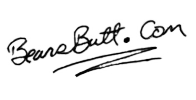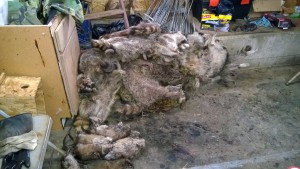There is a lot to read both in books and on the internet about proper fur handling. It is really easy once you get a handle on how it’s done, but then too it is VERY easy to stop doing some of the little steps that could just make your stack of furs not look as good as they could. I’ve told you some of the reasons that the wild fur demand is not what it was even a year ago and prices are at a low we haven’t seen for a few years. We sold a raccoon at the auction last January and received a check for $.23….That’s right! The fur sold for a quarter and after the commission for the auction house we netted a whole 23 cents! Not even a fourth of what is needed for a cup of coffee at the cheap place. We took a lot of pride in those raccoons and put them up according to the book. It wasn’t because it was shabbily put up, but more because it probably wasn’t fully prime, but still, what would we have gotten had we not done to it what we did?
So, with that illustration of market prices, you can still make a few dollars if you go above and beyond what is needed in order to sell your furs for a fair price.
With our muskrats, we want the fur side very dry before we put them on the stretchers. After skinning them, if they show any signs of being wet, we lay them on a drying rack or hang them from the over head rafters of the skinning shed where they will get the most benefit from our 60 degree heater. We maintain the rafter area of the shed at 55 to 65 degrees and we tend to lean towards the 55 temp more than the upper temp. We accomplish that with a small heater that can be regulated to turn itself on and off based on the setting we use. I picked it up at a garage sale for $5 and it works very well.
When the furs are completely dry, Weasel grabs up a curry comb once used to groom the horses and goes to work making sure he gets any burrs, weed seeds and mud out of the fur and also makes sure the fur fluffs up really nice. When his Quality Control mind says it’s perfectly combed, he tosses it to me….I’m the fleshing man.
I’ll turn the hide fur side in and place it on the fleshing board and go to work with my fleshing tool. My choice of fleshing tools is a plain old windshield ice scraper. Most of them have sharp corners and so I begin by filing off the sharp edges, as these have a tendency to snag the hide and rip holes while you aren’t looking. My fleshing board is one I have to lean into. It is long enough to come up to my belt buckle and I place the butt end of it against the wall and scrape down the hide. A little “grease” left on the hide is totally acceptable, but no meat or large chunks of fat can be left anywhere on the hide. When the hide is adequately fleshed, I take it off the board and hand it to my brother Bob.
Bob is the oldest in the family and has been trapping nearly his whole life. He is old enough to know the business from end to end. I think if it were not for trapping he wouldn’t be in the healthy shape he is in. He takes the hide and positions it on the stretcher making sure it is centered. The leg holes, eyes and ears must be in a certain position before he pins the nose with a clothes pin and then pulls the hide down tight at the bottom of the stretcher.
A lot of guys will just pull the hide down on the stretcher without the clothes pin holding the nose. This causes the “mouth” hole to stretch out and the end of the stretcher protrude above the hide. A totally acceptable practice, but it makes for hides that are not uniform, gives an impression to the buyers that the trapper doesn’t care much and so they will offer less than what maybe the hides are really worth.
Take this for what I might be imagining, but if I were a fur buyer and came across a batch of prime hides, full of burrs, mud, put up while wet and the mouth ends of them were wide, I would not offer a very high price for them. After all, once I own them, they are reflecting on MY character and even if the auction house buyers are un-caring about how the hides look I like to think MY hides are the best in the building. On the other hand, if I came across a batch of prime hides with uniform mouth (nose) ends, combed, put up dry and all looking very uniform in shapes, I’d tend to pay a higher price for them as they will reflect MY way of thinking and WOULD be the best looking batch of hides in the auction house. Think about it.
Well, that is what we have right now, 515 perfectly put up rats, all ready for the local fur buyer to come and take a look at and give us a price. We like to deal with a “straight through price”, one in which the buyer says “I’ll give you X dollars for each rat you have and I won’t grade them”! 515 times $ = he takes them and we wish him the best of luck at the auction house! Bob always likes to think he will net the biggest and best price for his furs out of all the other trappers in this end of the state and 9 out of 10 times he does. I’ll help him catch and put them up, but they are his in the end and he negotiates the price. I don’t like the haggling end of the business.
He keeps me informed as the buyers begin their haggling. Of course they want the furs for the least amount of money they have to give and we want the most because we know they are worth it. Of course everyone knows that nobody wants to come out losing. We know that and are fair with out side of the bargain, but we also know what they are worth. We are into them our gas money, wear and tear on the vehicles and a token amount for our time in the skinning shed. Anything over that we consider a profit that will cover the cost of something we are dreaming about obtaining with our fur checks this year. If, however the buyers don’t come through with what we figure a good price….well….we have enough freezer space to keep them until next year. 515 rats is a good catch and a fair bargaining number, but with next years catch, we would have over 1,000 rats AND that my friend is a much bigger bargaining batch of perfectly put up rats!
Bears Butt
March 24, 2015


 Utah Fishing Reports
Utah Fishing Reports
Leave a Reply